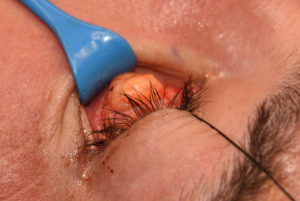Blepharoplasty is a broad term that implies an aesthetic procedure to the upper or lower eyelids. As a cosmetic procedure it has its origin in the treatment of the aging older eyelid where skin and fat removal are done in a more complete blepharoplasty surgery.
But the earliest signs of aging around the eyes are less dramatic and often present on the lower eyelids as bulging fat pads or lower eyelid ‘bags’. These protrusions are caused by the development of the three fat pads of the lower eyelid that become herniated in varying amounts. As we age the tissues holding the fat pads back into the orbit become weak and the fat protrudes forward. Often this fat pad ‘show’ is the only lower eyelid change with no significant loose skin or wrinkling.
Removal of the herniated lower eyelid fat pads is done through a transconjunctival lower blepharoplasty procedure. This avoids an external skin incision which is needed if skin removal is involved. Going through the inside of the lower eyelid (conjunctiva), the orbital septum is exposed while staying under and not disrupting the overlying orbicularis muscle. This essentially eliminates the risk of lower eyelid retraction which can occur with the skin and orbiculares muscle is disrupted.

The transconjuncival lower blepharoplasty is an ideal procedure for the younger patient who needs little to no skin removal. it can be safely combined with external topical skin treatments such as laser resurfacing, chemical peels and even a pinch of lower skin removal..
Dr. Barry Eppley
Indianapolis, Indiana


